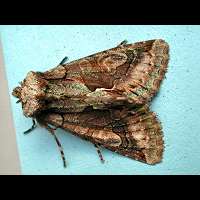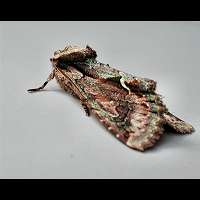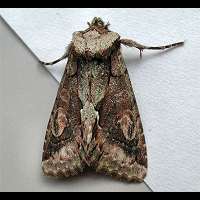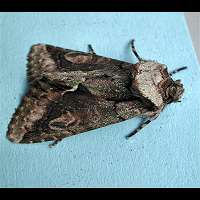Green-brindled Crescent Allophyes oxyacanthae
At first sight the Green-brindled Crescent is very similar to quite a number of brownish owlet moths. A close look however reveals beautiful green scales at many places on the wings. Add to this that this species is on the wing in late summer and autumn and you will understand why we call the Green-brindled Crescent quite unmistakable. There are darker and less well marked animals though. The wingspan varies from 39 to 46mm.
In autumn the female deposits her eggs one by one near a bud of the foodplant. The eggs are yellow first, but then become greyish red. They overwinter and only hatch in April of next year. The young caterpillars live inside the bud and eat it. Later they move around more and eat full grown leaves. By June or July the larvae move to the ground, where they dig a chamber deep in the soil. Here they make a very firm cocoon. They stay dorment inside the cocoon for weeks, before pupating. The caterpillars of the Green-brindled Crescent are greyish, usuallu brownish grey, but sometimes greenish grey. On the back are small, pale tubercles. On the 11th segment sits a pair of brown points. The head is reddish brown with darkbrown speckles and a black zig-zag line. The caterpillar is sometimes found on apple, plum or birch, but usually confines itself to Blackthorn and Hawthorn. It grows to a length of 42 to 48mm.
The Green-brindled Crescent is on the wing from mid-September to the beginning of November. It flies early in dusk and is seen on Ivy blossom in gardens regularly. Is fond of rotting fruit. Is not attracted to light easily and is easier to catch using sugar. Once caught this is an easy going species, which to a certain extend may even be handled. Photographing it usually is not a very tiresome task. But be aware: it may fly away suddenly without any warning signs. Quite common all over the British Isles, except for Northern Scotland and the Hebrides where it is a local species, getting rarer going northwards. A widespread, but local species on the continent, completely absent in certain areas.
At first sight the Green-brindled Crescent is very similar to quite a number of brownish owlet moths. A close look however reveals beautiful green scales at many places on the wings. Add to this that this species is on the wing in late summer and autumn and you will understand why we call the Green-brindled Crescent quite unmistakable. There are darker and less well marked animals though. The wingspan varies from 39 to 46mm.
In autumn the female deposits her eggs one by one near a bud of the foodplant. The eggs are yellow first, but then become greyish red. They overwinter and only hatch in April of next year. The young caterpillars live inside the bud and eat it. Later they move around more and eat full grown leaves. By June or July the larvae move to the ground, where they dig a chamber deep in the soil. Here they make a very firm cocoon. They stay dorment inside the cocoon for weeks, before pupating. The caterpillars of the Green-brindled Crescent are greyish, usuallu brownish grey, but sometimes greenish grey. On the back are small, pale tubercles. On the 11th segment sits a pair of brown points. The head is reddish brown with darkbrown speckles and a black zig-zag line. The caterpillar is sometimes found on apple, plum or birch, but usually confines itself to Blackthorn and Hawthorn. It grows to a length of 42 to 48mm.
The Green-brindled Crescent is on the wing from mid-September to the beginning of November. It flies early in dusk and is seen on Ivy blossom in gardens regularly. Is fond of rotting fruit. Is not attracted to light easily and is easier to catch using sugar. Once caught this is an easy going species, which to a certain extend may even be handled. Photographing it usually is not a very tiresome task. But be aware: it may fly away suddenly without any warning signs. Quite common all over the British Isles, except for Northern Scotland and the Hebrides where it is a local species, getting rarer going northwards. A widespread, but local species on the continent, completely absent in certain areas.







